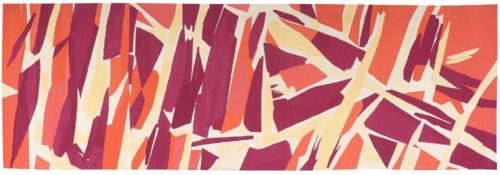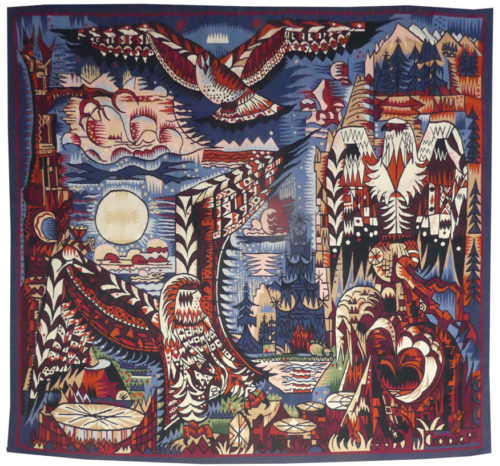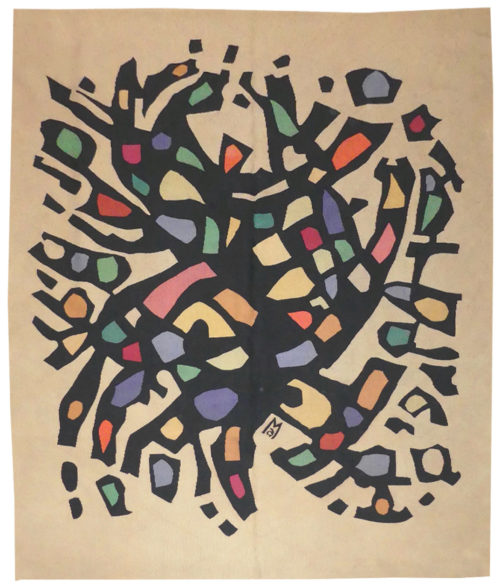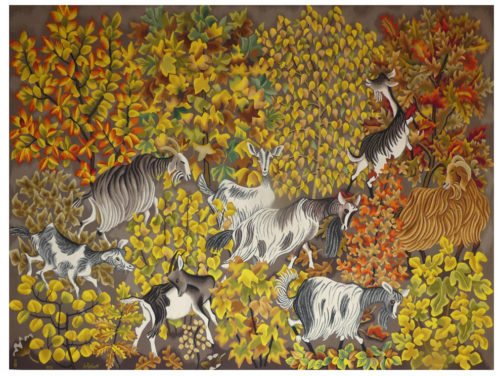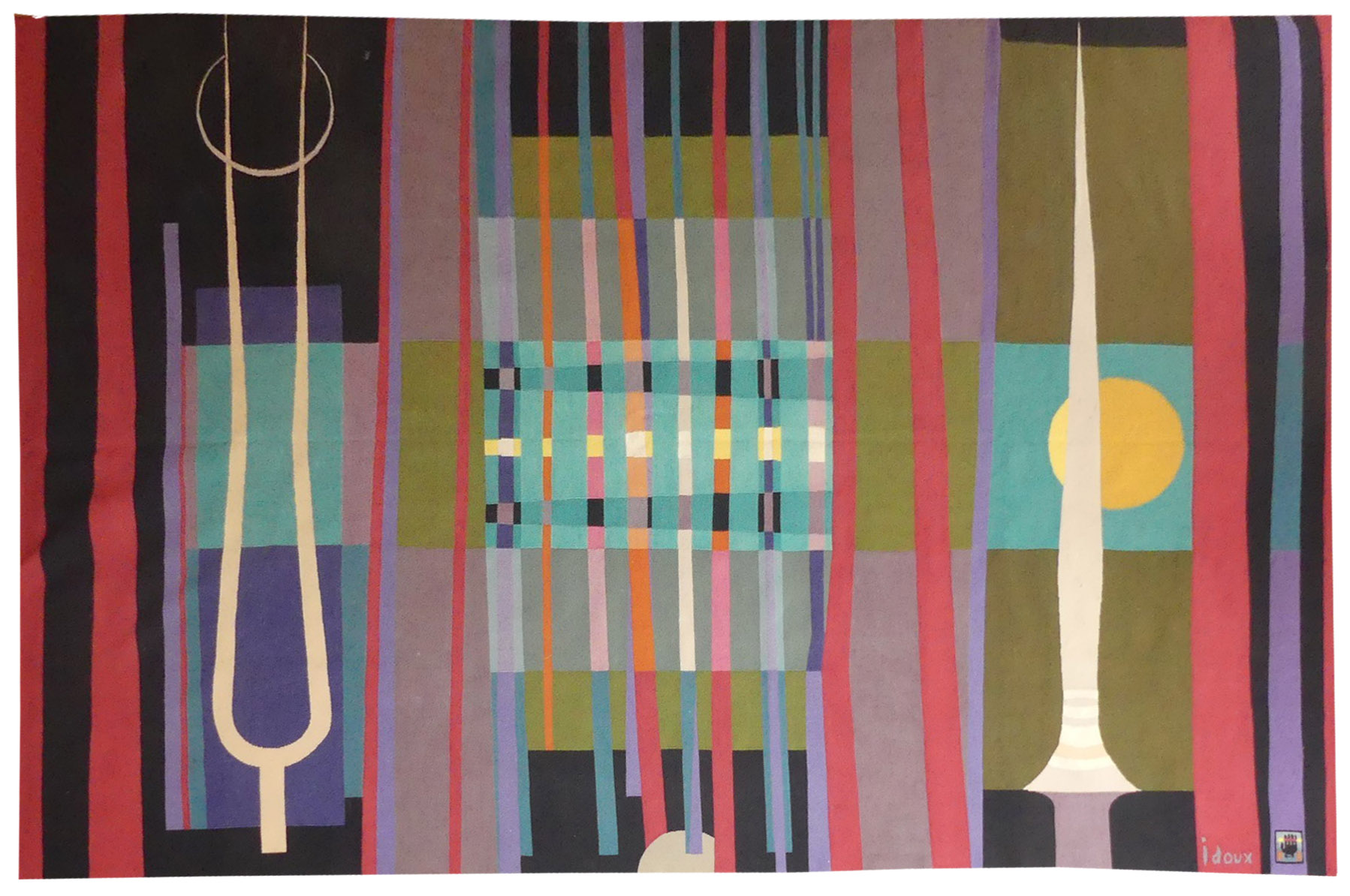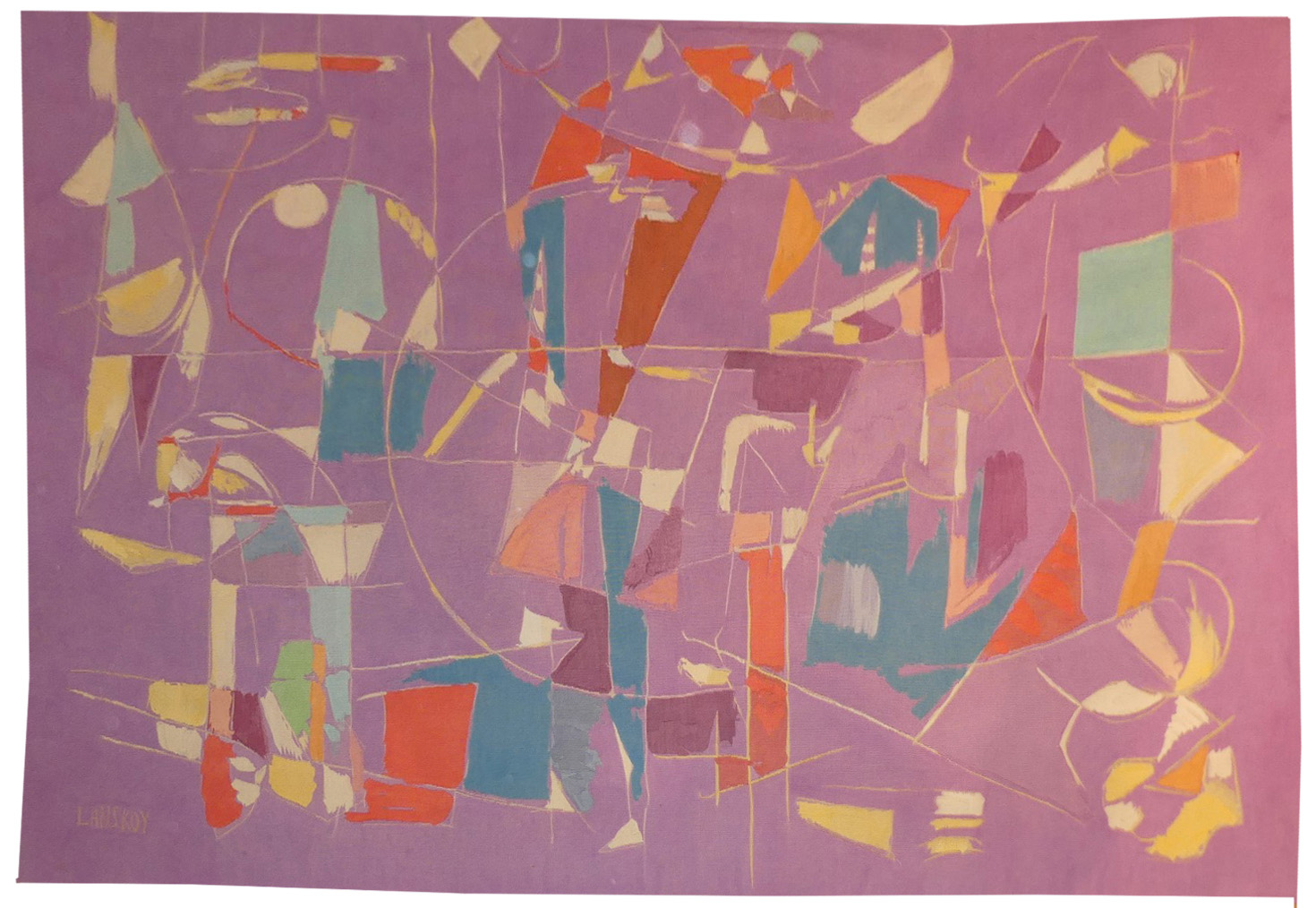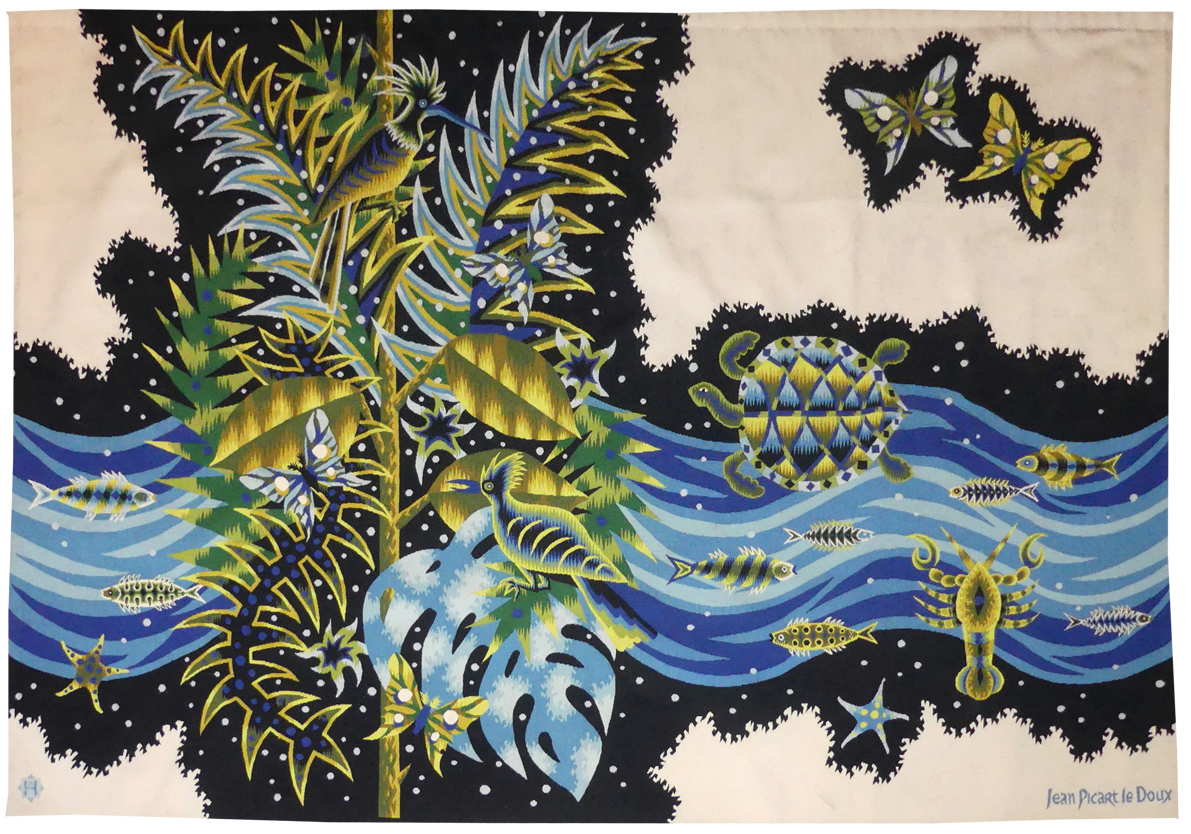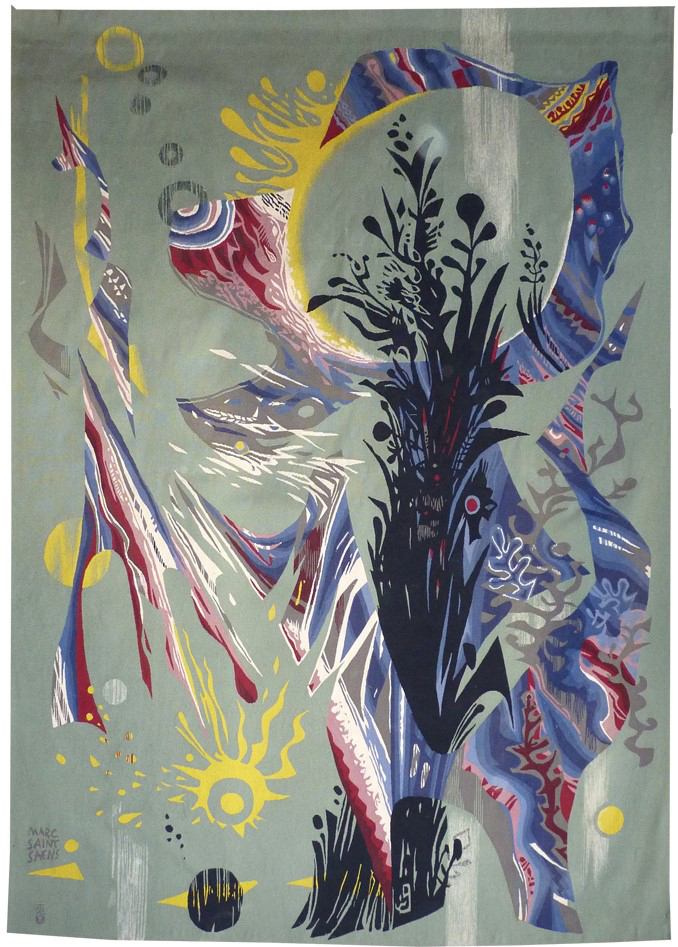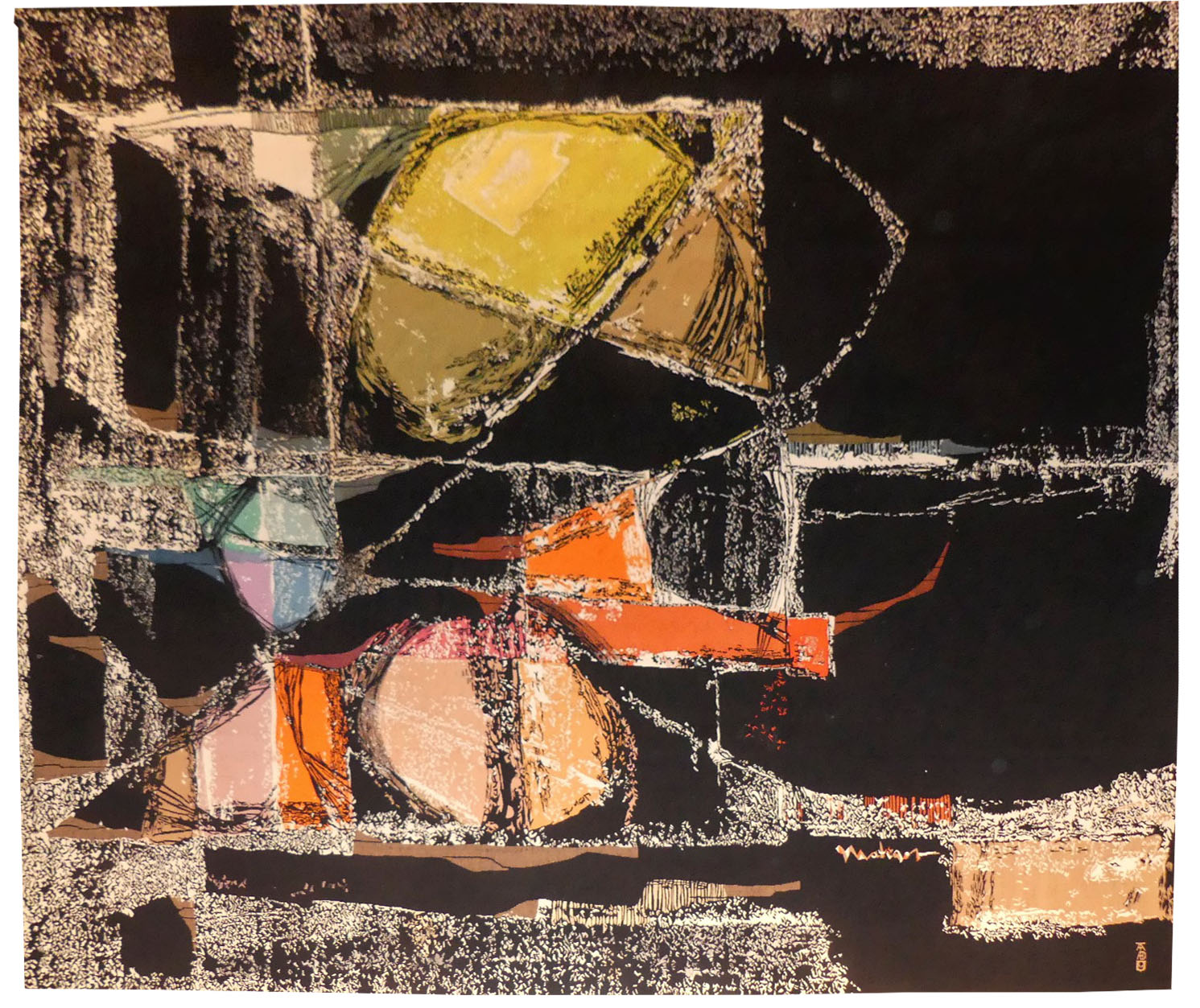-
Aubusson tapestry woven in the Goubely workshop. With label, signed with stamp, and by the artit's son, n°6/6. 1941.Gromaire’s woven pieces are few in number : 11 cartoons, designed between 1938 and 1944, most of them in Aubusson. “His rigorous construction, his use of simplification, his penchant for grand composition and grand fundamental ideas, his knowledgeable use of colour and in sum his supreme quality as a master-craftsman, all of those things were to make of him one of the most expert tapestry artists of his time”, so wrote Jean Cassou (Exhibition catalogue, Marcel Gromaire, Paris, Musée Nationale d’art moderne, 1963). It was Guillaume Janneau, then in the chair of the Mobilier National, who contacted him in 1938, convinced that his style (simplification of shape, geometrical designs framed in black, influenced by cubism, limited colour schemes…) would have something to contribute to the resolution of the new aesthetic problems that the art of tapestry would have to confront in order to bring about its renewal (simplified palette, synthetic cartoon design...) firstly with a commission for a work on the theme of the four elements, then with a second (“les saisons”, the seasons) which would be produced at Aubusson. In 1940 Gromaire joined Lurçat and Dubreuil there. Working alone, with great meticulosity (numerous drawings anticipate the cartoon which is painted rather than numbered as with Lurçat), in close collaboration with Suzanne Goubely, who would weave all his cartoons, he spent 4 years in Aubusson, during which time he devoted all his creative energy to tapestry. At the end of the war, he left the Creuse and produced no more cartoons, leaving to Lurçat the position of grand initiator of the tapestry renewal movement. « Oiseaux de proie » is one of the 5 tapestry cartoons designed by Gromaire for the Goubely workshop during the war and it is emblematic of his style : inspired by local landscapes, the absence of perspective, the strictly organised yet rich and highly abundant style, a limited palette (it is interesting to note the use at this period when France was occupied, the dominant colours of red, white and blue)... The atmosphere of this piece is more menacing than that of other pre-existing works.Bibliography : Tapisseries contemporaines Lurçat Gromaire, éditions Braun et cie, 1943, ill. Le Point, Aubusson et la renaissance de la Tapisserie, mars 1946, ill. p.35 Jean Lurçat, Tapisserie française, Bordas, 1947, plate 25 J. Cassou, M. Damain, R. Moutard-Uldry, la tapisserie française et les peintres cartonniers, Tel, 1957 Exhibition catalogue, Gromaire, œuvre tissée, Aubusson, Musée de la tapisserie, 1995, reproduced on p. 49 Symposium Jean Lurçat et la renaissance de la tapisserie in Aubusson, Aubusson, Musée départemental de la tapisserie 1992, ill. n°14 (detail) Exhibition catalogue La manufacture des Gobelins dans la première moitié du XXe siècle, Beauvais, Galerie nationale de la tapisserie, 1999.
-
Tapis de sol (Floor carpet)
Manessier was trained in the Bissière studio where he became familiar with decorative art (the sets for the 1937 Exhibition), and with applied arts particularly in the context of religious art (cartoons for stained glass, the design of liturgical ornamentation,...), and designed his first tapestry cartoon in 1947. Somewhat disappointed with the results, too well-defined and arid for his taste, he turned in the 1950’s to the Plasse le Caisne workshop. Exploiting a different technique which allowed for the contrast of stitches, materials, the use of relief, ... and a greater freedom for the weaver who thus engaged in a close collaboration with the cartoon designer, Plasse le Caisne went on to weave most of Manessier’s tapestries, some of them particularly large-scale (“Chant Grégorien” for the Maison de la Radio,...), some of them forming a cycle (the 12 “Cantiques sprituels de Saint Jean de la Croix),... Very much a one-off in Manessier’s work : a rug, but woven using the Aubusson weaving technique in the Goubely workshop (the only time they worked for the artist) ; it was a commission from Myriam Prévot, co-director of the Galerie de France, which was very active in the promotion of most of the non-figurative and lyrical abstract painters (organising 7 separate exhibitions devoted to Manessier), for her flat on the quai d’Anjou : underlying the close relationship between the artist and the gallery owner who represented him. Bibliography : Exhibition Catalogue Manessier, oeuvre tissé, Eglise du château de Felletin, 1993 (ill. p.39)Aubusson carpet/tapestry woven by the Goubely workshop. 1959. -
Chèvrefeuilles (Honeysuckle/Goats and leaves)
Aubusson tapestry woven in the Goubely workshop. With signed label, n°1. 1973. A Benedictine monk and an illuminator, Dom Robert met Jean Lurçat in 1941 at the Abbey of En Calcat : while he never abandoned drawing (his watercolours, painted to life, would serve him as a reservoir of ideas for his tapestries), his work as a cartoonist (he was a member of the A.P.C.T. from its inception) would take on a considerable importance (at least a hundred cartoons, all numbered) and would be highly thought of. His immediately recognisable style, absence of perspective¸motifs inspired from the natural world (in a Paradisiac style) where stylised flora and fauna combine in a festive and extrovert exuberance, where the influence of mediaeval tapestry can be clearly felt ; poetic and colourful, Dom Robert’s cartoons are the incarnation of their author’s spiritual asceticism. Inaugurated in the Spring of 2015, the musée Dom Robert opened its doors in in the monastery-school in Sorèze in the department of the Tarn. Goats and foliage in all their variety, rather than « Honeysuckle » (Chèvre means goat and feuille means leaf in French n.tr.), Dom Robert was never one to turn his back on the possibility of a pun (as in “Plein champ” meaning Open field but to the ear it can be confused with Plainchant tr.n.). It is interesting that a goat appears also in that tapestry design from 1970. Here, on a uniquely large scale for this subject, the goats are displayed against an autumnal background, a reference to “l’Automne” (Autumn) which was the last of the series The Seasons completed in 1943. A similar design is on display at the Cité Internationale de la Tapisserie in Aubusson. Bibliography : Exhibition Catalogue Dom Robert, tapisseries récentes, galerie la Demeure, 1974, ill. p.15, cartoon p.23 Multi-authored, Dom Robert, Tapisseries, Editions Julliard, 1980, ill p.70-71, detail on front cover, cartoon p.85 Multi-authored, Dom Robert, Tapisseries, Editions Siloë-Sodec, 1990, ill. P.62-67 Exhibition Catalogue, Dom Robert, œuvre tissé, Angers, Musée Jean Lurçat et de la tapisserie contemporaine, 1990 Exhibition Catalogue, Hommage à Dom Robert, Musée départemental de la tapisserie, Aubusson, 1998 Multi-authored, la clef des champs, Dom Robert, Editions Privat, 2003, ill. p.124 Multi-authored, les saisons de Dom Robert, Tapisseries, Editions Hazan, 2014, ill p.164-167 B. Ythier, Guide du visiteur, Cité Internationale de la tapisserie d’Aubusson, ill. p.65 R. Guinot, hors-série la Montagne, une Cité pour la tapisserie d’Aubusson, 2018, ill. p.82 Multi-authored, la tapisserie française, Editions du Patrimoine, 2017, ill. 312-313 -
Composition
A friend of both Bertholle and Le Normand, with whom he produced several frescoes in the 1940’s, Idoux produced his first tapestry cartoon in 1946 and joined the A.P.C.T. in 1951. His tapestries, where geometrical and optical effects resonate in a grand harmony (and this is only the beginning of the 1950’s!) hark back to his work in stained glass (the church of Notre Dame in Royan for example). As a confirmation of his meteoric rise in the world of tapestry (producing around twenty cartoons in ten years), official recognition came with a commission for two tapestries “Jardin Magique” and “Fée Mirabelle” which were created for the 1st class saloon of the Atlantic ocean liner “France” (“Jardin Magique” is now kept at the eco-museum in St Nazaire).Aubusson tapestry woven in the Rivière des Borderies workshop. Circa 1950. -
Treilles (trellis)
Aubusson tapestry woven in the Pinton workshop for Leleu. With label. 1964.With a taste for the large-scale, influenced by Untersteller at the Ecole des Beaux Arts, Hilaire undertook numerous mural paintings. In the same vein, beginning in 1949, along with a number of other artists stimulated by Lurçat, (he would join the latter at the A.P.C.T. Association des Peintres-Cartonniers de Tapisserie) he designed a number of cartoons some of which were woven at Beauvais or at Les Gobelins. This tapestry hung in the dining-room of the villa Médy Roc, at the Cap d’Antibes, for which the Leleu studio designed furnishings and fittings starting in 1957 : their philosophy, inspired by Jacques Adnet’s theories of the interweaving of architecture, furniture and tapestry design , which should all be unified by a single view, was to lean into the idea of a tradition of good taste “à la française”, as interpreted by the best designers and artists of the period. With this in mind, another work, also by Hilaire, “Jardin à la française” was already in place in the dining-room before this tapestry, where a traditional trellis shelters birds of more exotic plumage, was installed in the same area in 1964. Both works appear in the film “Les seins de glace”, directed by Lautner featuring Delon, Brasseur and Mireille Darc, which was filmed on location in the villa. Provenance : villa Médy Roc, Cap d’Antibes Bibliography : Exhibition catalogue Hilaire, œuvre tissé, galerie Verrière, 1970 Exhibition catalogue, du trait à la lumière, Musée Départemental Georges de la Tour at Vic-sur-Seille, 2010. -
Composition
Tapestry, probably Aubusson woven. Circa 1970 If Lanskoy’s work starts to evolve towards the abstract from the beginning of the 1940’s, his first cartoons date from the 1950’s : thus they are all abstract. Originally working with Picaud’s workshop at Aubusson, he would go on to collaborate with Maurice Chassagne (on whose productions there never appears any indication of the workshop nor certificate of authenticity), but his work was also woven by the Manufactures Nationales, and “Consolation” would be hung in the ocean liner “France”, undeniable proof of official recognition for this artist. A major protagonist of lyrical abstraction whose work was championed by the major art galleries of the period (Jeanne Bucher, Louis Carré), Lanskoy whose luxuriant painting style employed a festival of colours (pinks, mauves and oranges are frequent) avoided his characterestic layering of paint when he produced work for weaving. In the same more contained more vein, the forms employed tend to be less exuberant. -
Amazonie (Amazonia)
Aubusson tapestry woven by the Hamot workshop. With signed label. 1962. Jean Picart le Doux is one of the foremost figures in the renaissance of the art of tapestry. His earliest contributions to the field date back to 1943 when he designed cartoons for the passenger ship “la Marseillaise”. A close associate of Lurçat, whose theories he would adopt (limited palette, numbered cartoons...), he was a founding member of the A.P.C.T. (Association des Peintres-cartonniers de Tapisserie), and soon after, a teacher at the Ecole Nationale Supérieure des Arts Décoratifs. The state gave him several commissions most of them at the Aubusson workshop, and some at the Gobelins : the most spectacular of these being for the University of Caen, the Theatre in Le Mans, the passenger ship France or the Prefecture of the Creuse département ... In as much as Picart le Doux’s aesthetic is close to that of Lurçat, so also is his inspiration and his subject matter, although in a register which is more decorative than symbolic, where he brings together heavenly bodies (the sun, the moon, the stars...), the elements, nature (wheat, vines, fish, birds...), man, literary quotation ... Since « Orénoque » dating from 1956 (Bruzeau n°72), South America recurrs regularly in the work of Picart le Doux. Here “la huppe”, a vertical cartoon (Bruzeau n°97) is enlarged horizontally by the addition of the river peopled with turtles, fish ...in a highly effective decorative ensemble. Bibliography : Marthe Belle-Jouffray, Jean Picart le Doux, Publications filmées d’art et d’histoire, 1966, ill. n°5 Maurice Bruzeau, Jean Picart le Doux, Murs de soleil, Editions Cercle d’art, 1972, ill. n°129 Exhibition Catalogue, Jean Picart le Doux, tapisseries, Musée de Saint-Denis, 1976 Exhibition Catalogue Jean Picart le Doux, Musée de la Poste, 1980, n°14 ill. -
Ornements (ornaments)
Aubusson tapestry woven in the Tabard workshop. With certificate of origin signed by the artist, n° 4. 1963. Lurçat approached Saint-Saëns, originally a painter of murals, in 1940. And during the war the latter produced the first of his allegorical masterpieces, tapestries reflecting indignation, combat, resistance : “les Vierges folles (the foolish virgins), “Thésée et le Minotaure” (Theseus and the Minotaur). At the end of the war, as a natural development he joined up with Lurçat, whose convictions he shared (concerning a simplified palette, outlined cartoons with colours indicated by pre-ordained numbers, and the specific nature of tapestry design...) at the A.P.C.T. (Association des Peintres-cartonniers de Tapisserie). His universe, where the human figure, stretched, elongated, ooccupies an important place (particularly when compared to his companions Lurçat or Picart le Doux), pivots around traditional themes : woman, the Commedia dell’arte, Greek mythology... refined by the brilliance of the colours and the simplification of the layout. His work would evolve later, in the 1960’s, towards cartoons of a more lyrical design, almost abstract where elemental and cosmic forces would dominate. This cartoon can be seen as belonging to this particular style. Here is an extract from the 1987 catalogue of his works (p37) : “Ornements, a purely decorative tapestry, resembles Dédale, Biologie (property of the Head office of the CNRS), Bel Canto, in its pure and ample style, flowing and lyrical, very close to the painted studies where Saint-Saëns loosed his passion for freely spread colour.” This cartoon was produced in a series of 5. Bibliography : Exhibition catalogue Saint-Saëns, the tapestries, Aubusson, Musée départemental de la Tapisserie, 1987 (tapestry included in the exhibition but not illustrated in the catalogue) Exhibition catalogue Marc Saint-Saëns, tapestries, 1935-1979, Angers, Musée Jean Lurçat et de la Tapisserie Contemporaine 1997-1998 (ill.p 22) Exhibition Catalogue Marc Saint-Saëns, galerie Moulins, PAD 2010 (ill. p.16) -
Matégot, originally a decorator, then creator of artefacts and furniture (an activity he abandoned in 1959) met François Tabard in 1945 and gave him his first cartoons, first of all figurative then rapidly of abstract design in the 1950’s. He became a member of the A.P.C.T. (Association des Peintres Cartonniers de Tapisserie) in 1949, participated in many international exhibitions (Matégot, like Lurçat before him, was an untiring advocate of the art of tapestry) fulfilled numerous public commissions, sometimes of monumental proportions (“Rouen” 85m2 for the Préfecture of the Seine Maritime département, and also tapestries for Orly Airport, for the Maison de la Radio, for the IMF...) and designed no fewer than 629 cartoons up until the 1970’s. In 1990 the Matégot foundation for contemporary tapestry was inaugurated in Bethesda, U.S.A. Matégot is an artist, like Wogensky, Tourlière or Prassinos, who turns wool textiles resolutely towards the abstract: at first lyrical, geometric in the 70’s, exploiting various technical aspects of the loom : colour graduations, shading, irregularities... While Matégot's interest in aeronautics was very strong at the time (his tapestry for Orly in particular dates from 1959, ‘Cap Canaveral’ from 1958...), his liking for the treatment of great myths is echoed here: Icarus (there was also ‘Vulcan’, ‘Daedalus’...), serves as a transition, in an identical treatment (to be compared with ‘Orly’), to evoke the same conquest of the Air... Bibliography : Waldemar Georges, Mathieu Matégot, Prisme des Arts special issue, 1957 Exhibition catalogue, Matégot, Angers, Musée Jean Lurçat et de la Tapisserie Contemporaine, 1990-1991, ill. p.31 Patrick Favardin, Mathieu Matégot, Editions Norma, 2014
Icare (Icarus)
Aubusson tapestry woven by the Tabard workshop. N°1/6. 1960.


